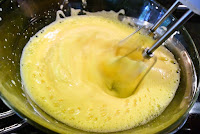Whole cake (18 cm mold):
1135 calories; 27.2 g protein; 43.2 g fat; 154.6 g carbohydrate; 152.4 g net carbs; 231 mg sodium; 713 mg cholesterol; 2.2 g fiber
<Ingredients>
3 eggs
80 g sugar
1 tsp maple syrup
80 g all-purpose flour
10 g katakuriko potato starch (or corn starch, tapioca starch, rice flour)
30 g unsalted butter
2 tbsp milk
<Directions>
1.
Preheat oven to 325 F (160-165 C).
2.
Thinly spread butter (not included in ingredient list above) on the bottom and sides of cake mold, and line with paper.
3.
Mix flour and potato starch well, and sift 3 times (at least 2 times).
4.
Break eggs in a mixing bowl.
Place bowl in a pot with enough water on stove (heat water on medium-low heat), and beat at the highest speed until somewhat foamy.
Add sugar to eggs, 1/3 at a time, and continue beating until egg mixture makes creamy, soft peaks when lifting whisk.
(While beating and mixing in sugar, remove egg mixture from hot water when it becomes somewhat warmer than body temperature.)
Lower speed of mixer, and continue beating egg mixture for 1-2 minutes to create fine foam.
Add maple syrup (room temperature or warmer), and mix well.
5.
Meanwhile, remove hot water pot from heat, discard water as necessary, and place butter + milk container in hot water to melt butter.
Remove from hot water when butter is completely melted, and keep warm (ideally, hotter than bathwater).
6.
Sift in half of flour + potato starch mixture.
Switch to a hand whisk, hold horizontally, and fold flour mixture into egg mixture.
Starting from the far end of mixing bowl, move whisk along the bottom toward you, bring into the air while scooping, and let the batter-to-be fall through whisk wires back into the bowl.
Turn the bowl counterclockwise a few centimeters (20-30 degrees), and repeat until flour mixture disappears.
Sift in remaining flour mixture, and fold again in the same way.
Slowly swirl in butter + milk mixture, and mix in the same way.
Now you have a glossy batter ready to bake!
7.
Pour batter into mold from 20+cm above kitchen counter.
Drop mold from 15-20cm above kitchen counter to let out large bubbles in batter.
8.
Bake for 40-45 minutes, or until an inserted skewer comes out clean when removed.
9.
Drop the cake from 20-30 cm above kitchen counter to let out hot air in the sponge.
(This prevents it from shrinking while cooling.)
10.
Let the sponge cool somewhat in mold, and take out of mold.
Remove side paper as necessary, flip onto a cake rack (small grill in photo), remove bottom paper, and flip onto another cake rack.
Let cool completely.
<Notes>
- If using cake flour, replacing some portion with other starch is not necessary. In Japan, hakurikiko (cake flour) is widely available. All-purpose flour in the US is churikiko (also called udonko [udon flour]) in Japan. By replacing around 15% of all-purpose flour with starch, a result similar to the sponge made with hakurikiko is achieved.
- Instead of maple syrup, honey or other syrup can be used. It is not essential, and can simply be skipped.
- In the above example, the egg mixture temperature was a bit too high (mixing bowl was kept in hot water too long). This results in a slightly taller sponge than usual, but the texture was not as fine as it should be ... while the difference is minor, temperature does affect the overall delicateness of the sponge.
- Use the freshest eggs possible!
- After pouring batter into the mold, some batter remains in the bowl. Scrape with a spatula and put it toward the edge of the mold. Putting this portion (thicker consistency) in the center makes the sponge center heavy.
- Misting the batter surface before baking helps to make the sponge surface flat. If a mister is not available, gently flatten batter with a spatula, if necessary.
- If keeping the sponge more than a half day before use, cover or store in a plastic bag.
Recipe with genoise sponge cake
- Ichigo no shootokeeki / layered sponge cake with strawberries
(Last updated: May 23, 2015)



























No comments:
Post a Comment